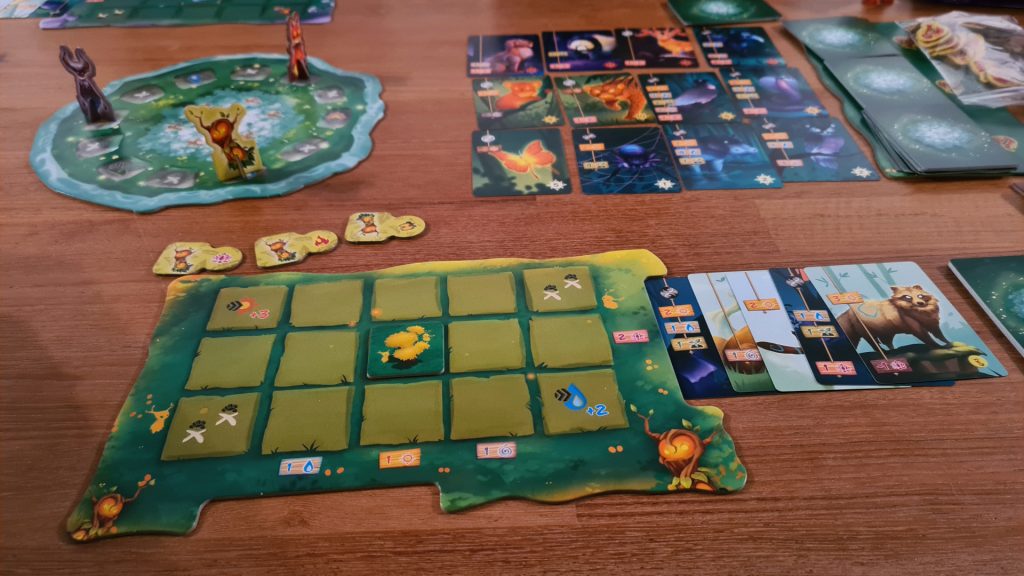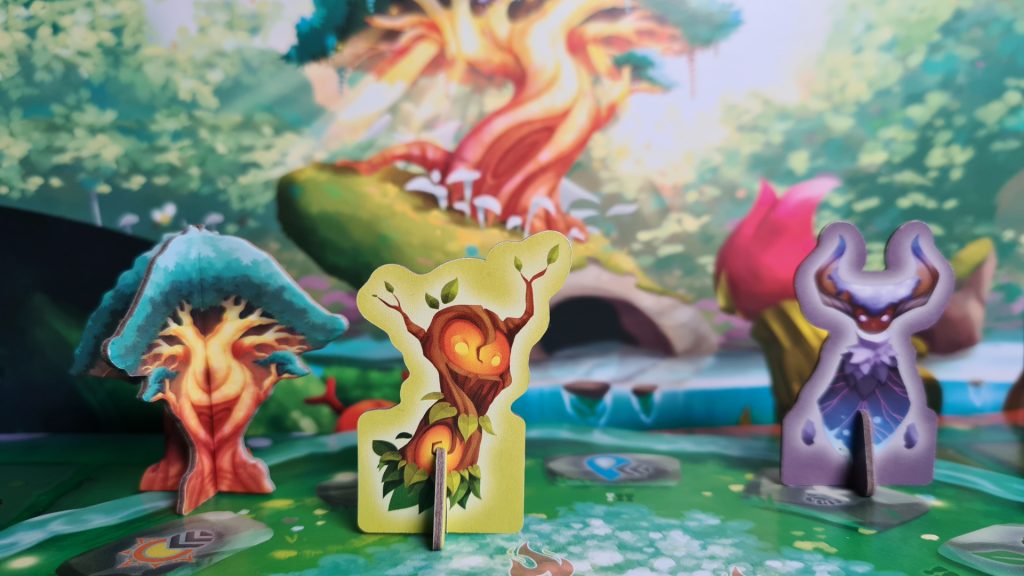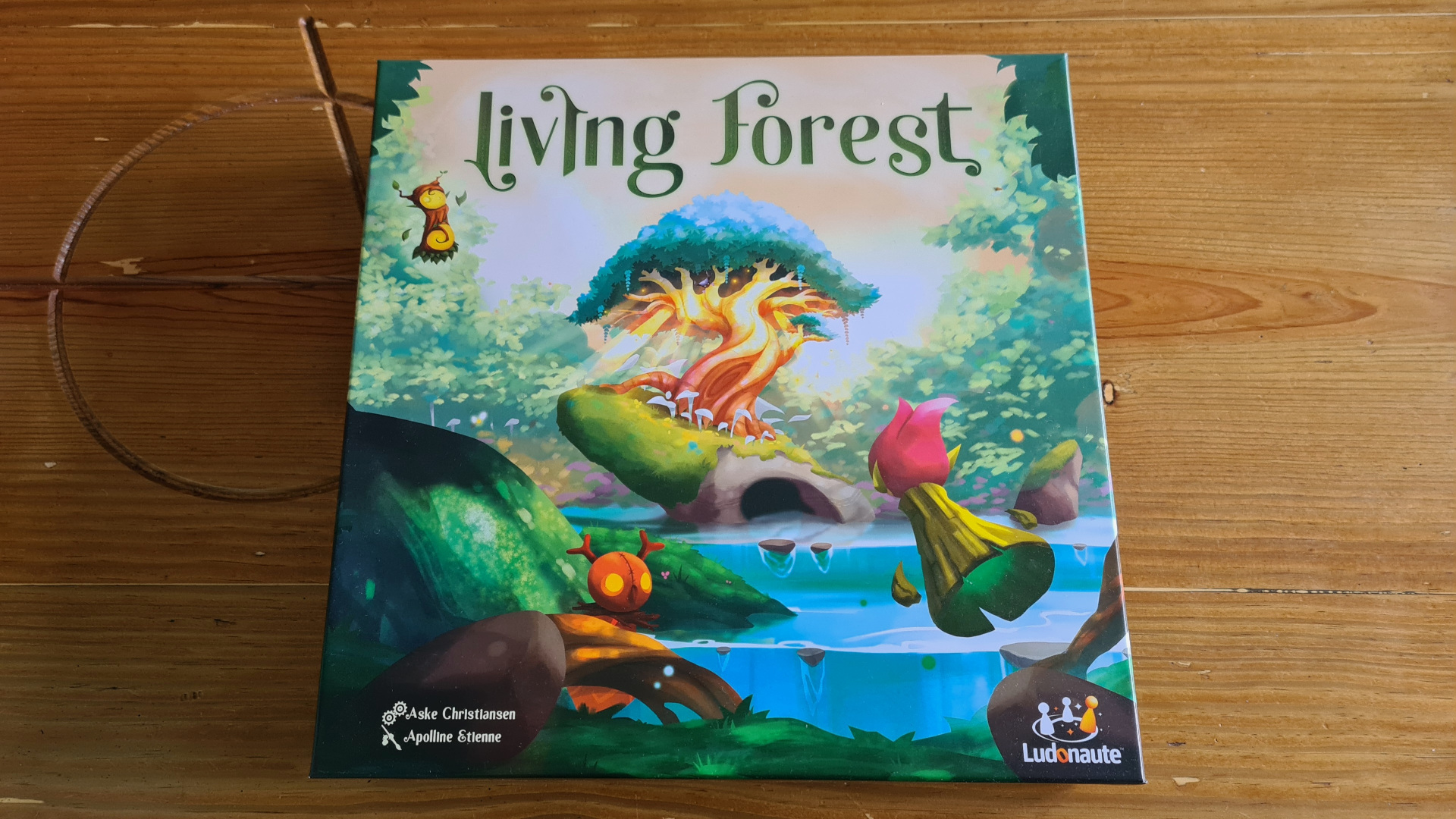Living Forest is the brand new push your luck, fantasy animal themed, board game from publisher Ludonaute. Designed by Aske Christiansen, featuring artwork from Apolline Etienne, the game sees 2 – 4 players take up the role of nature spirits, whom are looking to save the forest. By building up a deck of animal guardians, players will plant trees, put out the fires caused by Onibi and try not to get burnt doing so. However, is this the nature themed game for you? Let’s find out!
Setting up the game each player chooses a nature spirit, placing the spirit’s standee onto the circle of spirits central board; taking the associated starting guardians deck, protective tree tile and victory tiles. Claiming an individual forest player board, the players place their protective tree in the middle space. The remaining guardians decks are shuffled separately, based on their level. The top 4 cards of each deck are flipped to create a 12 guardian market, with a pile of fragment tokens and fire cards placed nearby. The market of protective trees is placed within reach and then the game is ready to begin.
Having no number of set rounds, the game is played one round at a time until one player has planted 12 different trees, played 12 sacred flowers in a turn or extinguished 12 fires. Each round is split into 3 phases. The first phase is the guardian animals phase. Players simultaneously play this phase, turning over one card from their deck at a time until they wish to stop or go bust. Some cards feature a solitary symbol. Turning over your third solitary symbol sees you go bust, and you must stop playing cards.
When everyone is done they move onto the action phase, in turn order this time players will perform 2 different actions, unless they went bust – where they can only perform 1 action. The strength of the actions depends on the cards played, as well as bonuses from completed rows and columns of planted trees. Sacred flowers will also feature on cards, being one of the three ways to win.

One action always available is to take a fragment tile. These can be used in future rounds to discard revealed solitary symbols or safely remove Fire cards from your deck. Players can instead attract guardians, spending their sun symbols on cards from the market. Note the market spaces are not instantly refilled. Each round fire will appear in the middle of the circle of spirits and players can spend their water as an action to extinguish fire up to their total water value.
Instead, a player may wish to spend their movement value to charge around the circle of spirits, leapfrogging the standees of others. Whenever a leapfrog occurs they get to take one victory token (fire, flower or protective tree) from them. Note, this is not taking an actual tree tile, just a victory token with a tree on it. Each space of the circle also depicts a bonus action, that the player may perform. The final action allows the player to spend their plant values to add any one protective tree to any adjacent space on their player board, with the corners awarding instant benefits.
At the end of the round if someone has reached 12 fire tokens, trees or sacred flowers played they win, otherwise the Onibi strikes back. The unextinguished fire tokens in the circle of spirits are summed. Every player who has a water total below this value gains as many fire cards as there are fire tiles. These are added into the player’s discard pile to eventually cause the player problems. Next, based on the cards purchased from the market a number of fire tokens are added into the middle of the circle of spirits, before the market is refilled. Players discard their played cards, before the next round commences.
Living Forest offers three distinct routes to victory, and they are actually possible. Often a game with various methods come back together, forcing players to compete in all ways or see the differing methods just giving victory points that add together. This isn’t the case with Living Forest as put out fires don’t stack in any way with the number of built trees.
Regardless of how players build their deck it feels like it is constantly improving. Buying additional guardians with movement symbols causes the player to run around the circle of spirits board faster, while more water symbols makes them that bit safer. Importantly, players are choosing what they are adding to their decks. This is limited by what’s in the market and what others buy, but there is commonly a choice between multiple cards. Which is especially the case as the game progresses and players can afford more expensive cards.

Alongside this players will also gain other benefits. Planting trees can unlock ongoing bonuses that add to the cards played, so you always have that safety of water or extra movement at your disposal. The only aspect which goes against this are the fire cards, which negatively clog up your deck. These have a point though as they are part of what drives the push your luck aspect of the deck building, alongside the other solitary denoted cards.
There’s no denying that Living Forest is a good looking board game. The personal player boards are slowly transformed into colorful forests. Still, it is the cards that really stand out. Each features an amazing illustration of often weird and wonderful looking creatures. Some are closer than others to real life animal counterparts, each just having that something extra, something magical, about them tweaked/added. Often deck building games reserve part of the card for art, with the rest used for symbols and such. In Living Forest the artwork is allowed to shine and not at the expense of being able to easily understand and use the iconography, which is down the left side of the cards.
Living Forest has a number of great aspects going for it. As the game progresses players will be able to spend more suns, plant more trees, and generally do more on any given turn. This allows new players to get their feet under the forest’s table before important choices need to be made. Then, there are the routes to victory, which are completely separate from each other.
Some players may not vibe as much with the push your luck aspects of the game. With pushed luck one player could turn a potentially great turn into an okay one, whilst someone else gets lucky and does the opposite. It’s always the players choice though and they’ll know what they have added to their deck. Living Forest is an interesting design that push your luck fans will love and others should definitely try to play.
(Editor’s Note:Living Forest was provided to us by Coiledspring Games for the review. The game is currently available from local board game stores! Find your local store here.)

